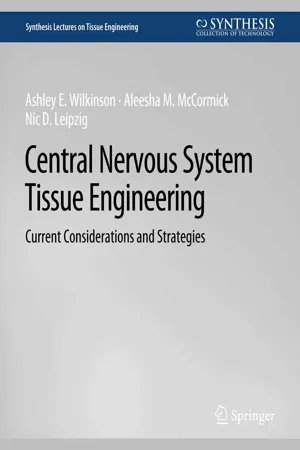
Central Nervous System Tissue Engineering
Current Considerations and Strategies
Ashley E. Wilkinson, Aleesha M. McCormick, Nic D. Leipzig
- English
- PDF
- Disponibile su iOS e Android
Central Nervous System Tissue Engineering
Current Considerations and Strategies
Ashley E. Wilkinson, Aleesha M. McCormick, Nic D. Leipzig
Informazioni sul libro
Combating neural degeneration from injury or disease is extremely difficult in the brain and spinal cord, i.e. central nervous system (CNS). Unlike the peripheral nerves, CNS neurons are bombarded by physical and chemical restrictions that prevent proper healing and restoration of function. The CNS is vital to bodily function, and loss of any part of it can severely and permanently alter a person's quality of life. Tissue engineering could offer much needed solutions to regenerate or replace damaged CNS tissue. This review will discuss current CNS tissue engineering approaches integrating scaffolds, cells and stimulation techniques. Hydrogels are commonly used CNS tissue engineering scaffolds to stimulate and enhance regeneration, but fiber meshes and other porous structures show specific utility depending on application. CNS relevant cell sources have focused on implantation of exogenous cells or stimulation of endogenous populations. Somatic cells of the CNS are rarely utilized for tissue engineering; however, glial cells of the peripheral nervous system (PNS) may be used to myelinate and protect spinal cord damage. Pluripotent and multipotent stem cells offer alternative cell sources due to continuing advancements in identification and differentiation of these cells. Finally, physical, chemical, and electrical guidance cues are extremely important to neural cells, serving important roles in development and adulthood. These guidance cues are being integrated into tissue engineering approaches. Of particular interest is the inclusion of cues to guide stem cells to differentiate into CNS cell types, as well to guide neuron targeting. This review should provide the reader with a broad understanding of CNS tissue engineering challenges and tactics, with the goal of fostering the future development of biologically inspired designs.Table of Contents: Introduction / Anatomy of the CNS and Progression of Neurological Damage / Biomaterials for Scaffold Preparation / Cell Sources for CNS TE / Stimulation and Guidance / Concluding Remarks
Domande frequenti
Informazioni
Indice dei contenuti
- Cover
- Copyright Page
- Title Page
- Contents
- Introduction
- Anatomy of the CNS and Progression of Neurological Damage
- Biomaterials for Scaffold Preparation
- Cell Sources for CNS TE
- Stimulation and Guidance
- Concluding Remarks
- Bibliography
- Authors’ Biographies